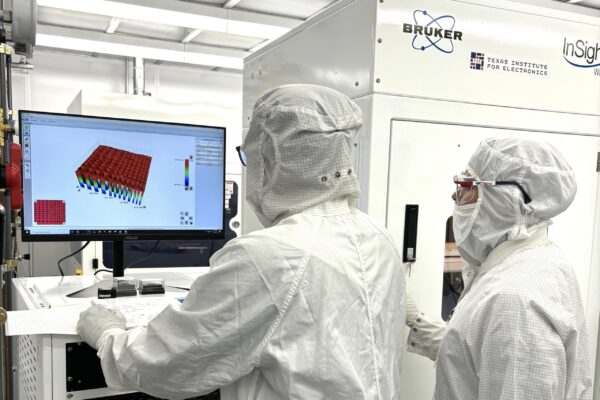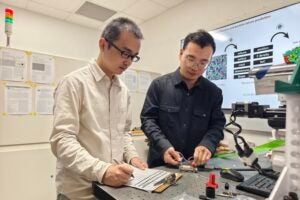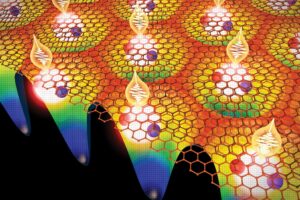As the pace of change accelerates in virtually all aspects of life, The University of Texas at Austin remains a constant in leading the most critical areas of research and development prioritized by the federal government to support our nation’s continued prosperity and security.
A White House memo outlining federal R&D priorities released last month showed close alignment with well-established strengths of UT Austin.
“Today, America’s Innovation ecosystem is built on a unique partnership between government, academia, industry, and nonprofit research institutions,” the memo read. “Universities have served as vital centers of scientific discovery and technical talent development. … Across this ecosystem, it is the role of the Federal Government to set clear priorities, align incentives, and ensure that public Investments translate into strategic advantage.”
The White House priorities include:
- critical and emerging technologies;
- energy dominance and exploration;
- national security;
- strengthening and safeguarding health and biotechnology; and
- space exploration.
Below are examples of UT’s leadership in each of these critical fields.
Critical and Emerging Technologies

Artificial Intelligence
For decades, UT has been a leader in AI and is growing its heavy involvement in AI research through initiatives such as the Machine Learning Lab and the National Science Foundation’s AI Institute for Foundations of Machine Learning (IFML), while also focusing on the ethical development of AI through the Good Systems initiative and establishing AI governance frameworks for campus use. The University is expanding educational programs and professional development in AI and generative AI to equip students and workers for the workforce.
Quantum Information Science and Technology
Within the past year, UT boosted its commitment to research and education in quantum science and engineering by establishing the Texas Quantum Institute. This investment reflects the University’s recognition of the vast potential that quantum science and engineering hold to benefit society through new approaches to computing, energy-efficient electronics, secure communications, ultrasensitive sensors for medical diagnostics, semiconductor quality control and observing climate processes from space. The Texas Quantum Institute joins other established quantum efforts on campus including UT’s Center for Dynamics and Control of Materials (an NSF-funded Materials Research Science and Engineering Center of excellence), which creates new quantum materials for application in quantum communications and information processing; and the Center for Space Research’s NASA Quantum Pathways Institute, which is enabling unprecedented levels of detail by using quantum sensing to track critical earth processes from space.
UT is home to the Center for Quantum Materials Engineering and plays a key role in the Quantum Information Center, both of which foster collaboration between physicists, engineers and computer scientists. UT researchers contribute to quantum computing, quantum algorithms and quantum error correction with strong theoretical foundations supported by practical experimentation. The University’s partnerships with national labs, industry leaders such as IBM and Microsoft, and participation in federally funded initiatives like the National Quantum Initiative further amplify its impact. UT also attracts top graduate students and postdoctoral researchers through programs such as the Quantum Cross-platform Advanced Training (Q-CAT) program.
Semiconductors and Microelectronics
The University is home to the Microelectronics Research Center, which conducts research in areas such as advanced transistor design, nanofabrication, photonics and materials for next-generation chips. UT plays a central role in national semiconductor efforts, including participation in the CHIPS and Science Act initiatives and partnerships with the U.S. Department of Defense, TSMC, Samsung and Intel. The University also launched the Texas Institute for Electronics, designed to accelerate semiconductor R&D and workforce development. With strong academic programs in electrical and computer engineering and a pipeline of skilled graduates, UT is helping shape the future of the global microelectronics industry.
Advanced Communications Networks
UT Austin is a recognized leader in advanced communications networks, innovating at the intersection of technology, data and connectivity. Through cutting-edge research in 5G, 6G, wireless systems and optical networking, UT’s faculty members and research centers are shaping the future of global communications infrastructure. Collaborative initiatives such as the 6G@UT research program within the Wireless Networking and Communications Group, industry partnerships and government-funded projects position the University as a hub where theory meets application.
Future Computing Technologies
UT is driving breakthroughs that shape how society will process, analyze and secure information in the decades ahead. With researchers advancing quantum computing, AI and high-performance computing, UT is bridging fundamental science with real-world applications. The University’s partnerships with industry leaders and government agencies amplify its impact, ensuring that discoveries move quickly from the lab to practical use. Combined with best-in-class facilities such as the Texas Advanced Computing Center — home to some of the most powerful supercomputers in the world — UT empowers students, faculty members and collaborators to push the boundaries of what computing can achieve.
Advanced Manufacturing
The Walker Department of Mechanical Engineering has a strong Advanced Manufacturing and Design research area focused on additive manufacturing (3D printing) and nanoscale manufacturing. They are pushing forward new machines, predictive modeling and design strategies, and they work on varied applications from medical devices to biomaterials. As robotics becomes more integrated into manufacturing, Texas Robotics, UT’s cross-departmental research center, has many application spaces: surgical robots, rehabilitation, autonomous vehicles, defense, manufacturing automation and more.
The Robotics Center of Excellence, funded by the U.S. Army, is fostering research in autonomy stacks, perception, navigation, vehicle/aircraft platforms, motion planning, etc. This includes work to enable multiple robotic platforms (ground and aerial) to coordinate in difficult environments. The Nuclear and Applied Robotics Group works on deploying advanced robotics in hazardous environments (e.g. nuclear, dangerous industrial settings), where automation, safety and remote operation are critical.
UT is part of a major DARPA-led initiative (NGMM: Next Generation Microelectronics Manufacturing) to create a national hub for advanced microelectronics manufacturing. This involves not only fabrication (including 3D heterogeneous integration) but also building tooling, EDA (electronic design automation) and supporting infrastructures that include emerging capabilities such as “digital twins.”
In terms of AI and human-in-the-loop control, UT researchers have contributed work such as “Robot Learning on the Job: Human-in-the-Loop Autonomy and Learning During Deployment,” which studies how robots can learn more robustly in real-task settings by combining autonomous behavior with human oversight.
Energy Dominance and Exploration

The University is a leader in energy and exploration through its combination of research expertise, industry partnerships and resource stewardship. As the flagship of the UT System, which has the nation’s largest university endowment of oil and gas lands, UT channels its revenues into advancing cutting-edge energy research, while also pioneering innovations in renewable energy, carbon capture, and sustainable exploration. With world-class programs such as the Bureau of Economic Geology within the Jackson School of Geosciences, and the Energy Institute, the University equips students and researchers to tackle global challenges in energy security and climate transition. By combining traditional energy strengths with forward-looking solutions, UT will be key to shaping the future of energy worldwide.
UT is extremely active in nuclear energy research, spanning reactor technology, radiation applications and computational modeling. Its Nuclear and Radiation Engineering Program (in the Walker Department of Mechanical Engineering) runs the Nuclear Engineering Teaching Laboratory, which operates a TRIGA Mark II research reactor and offers services like neutron activation analyses, isotope production, radiochemistry, materials testing and reactor safety. One major recent milestone is UT’s involvement in Natura MSR-1, a molten salt reactor (liquid-fueled advanced reactor) project. UT researchers helped design, perform safety analyses, and support licensing for the reactor. Natura MSR-1 is the first university-based molten salt research reactor to receive a construction permit from the U.S. Nuclear Regulatory Commission. UT also conducts computational nuclear energy research (modeling new reactor designs, simulating advanced materials, developing software that supports licensing and performance predictions). It is integrating “digital twin” concepts (virtual simulation models paired with real reactor systems) to improve reactor operation and component testing.
Hydrogen energy is a major research focus area at UT, answering questions about how to produce hydrogen more cleanly and how to integrate hydrogen into broader energy systems. UT scientists are exploring “geologic hydrogen” — that is, hydrogen produced naturally or stimulated from iron-rich rocks using catalysts to speed up processes such as serpentinization, without emitting carbon dioxide. Foam-Assisted Enhanced Hydrogen Recovery uses foam injection into rock formations to help capture and extract hydrogen bubbles, which tend to stick or get trapped if you just try the usual fluids.
Beyond production, UT is involved in policy, infrastructure and demonstration. It is a founding member and lead academic partner in the HyVelocity Hydrogen Hub along the Texas Gulf Coast, which aims to create one of the largest low-carbon hydrogen production hubs in the country. UT is also collaborating with companies such as SunHydrogen to build a solar-to-hydrogen system (photoelectrochemical reactors) at the Hydrogen ProtoHub research facility.
National Security

UT is a leader in national security research and teaching. Through its research centers, including the Clements Center for National Security and the Strauss Center for International Security and Law, UT brings together experts in engineering, policy, cybersecurity, defense technologies and global affairs. Its collaborations with the Pentagon, intelligence agencies and industry partners ensure that discoveries in areas such as artificial intelligence, advanced communications, cybersecurity and space defense translate directly into national security applications.
The University is deeply involved in defense and national security research through its Applied Research Laboratories and partnerships with agencies such as DARPA, the U.S. Army, and the Navy. Major projects include a recent DARPA award of $840 million to the UT-led Texas Institute for Electronics, as mentioned above, to build an open-access hub for microelectronics prototyping and 3D heterogeneous integration for defense systems (radar, satellite imaging, UAVs). UT also hosts ARL South, a regional arm of the Army Research Laboratory, which works alongside UT faculty members on synthetic biology, biosensors, materials and biological threats. In robotics and autonomy, UT works with the U.S. Army on projects for autonomous ground and aerial vehicles, human-in-the-loop adaptive learning, navigational systems, and sensor fusion in adverse or unstructured environments. Additionally, UT seeds applied defense research in collaboration with ARL:UT through its Creating Connections for National Security Research program.
Additionally, the DARPA-led NGMM hub (mentioned above) that UT participates in provides a critical national security advantage by re-shoring the manufacturing of advanced semiconductor technologies for military use.
Strengthening and Safeguarding Health and Biotechnology

With strong partnerships across medicine, engineering and the life sciences, and programs in biomedical engineering, pharmacy, molecular biosciences and public health, UT is advancing discoveries that improve overall health while addressing global challenges such as emerging diseases, drug development and biosecurity. Dell Medical School leads research institutes fostering innovation in patient care, biotechnology commercialization and health policy.
Additionally, UT has launched a monumental health care initiative to accelerate and expand its burgeoning medical district into a world-class academic medical center for education, research and patient care. The University of Texas at Austin Medical Center will start with two new hospital towers — The University of Texas MD Anderson Cancer Center and a UT Austin hospital. MD Anderson, the nation’s No. 1 cancer hospital, will expand its Houston footprint to Austin by building and operating a comprehensive cancer center, while UT Austin will build and operate a new specialty hospital. In addition, UT and MD Anderson have launched the Collaborative Accelerator for Transformative Research Endeavors intended to merge the unique strengths of each institution through research projects that possess strong potential to grow into signature programs of research.
The Department of Molecular Biosciences houses 60 distinct research labs with leading scientists making advances to combat threats ranging from infectious disease to cancer to environmental harms.
Space Exploration

UT is a leader in space exploration with partnerships with NASA, industry and international collaborators. UT’s Center for Space Research is an innovator in mission planning, design and execution of spacecraft, aircraft and ground-based campaigns. Center for Space Research expertise has led, supported and enhanced many missions that have improved our knowledge of complex processes ranging from how Earth’s system operates to exploring questions of fundamental physics.
Home to top-ranked aerospace engineering and physics programs, UT drives innovations in spacecraft design, planetary science and computational modeling that expand humanity’s reach beyond Earth.
The Texas Spacecraft Laboratory enables students and researchers to design and launch satellites, while faculty members lead missions that investigate asteroids, exoplanets and the origins of the universe. The new graduate specialization in Space Tech Entrepreneurship is a program for M.S. and Ph.D. students that provides them with a multidisciplinary education synthesizing the fields of aerospace technology, business and entrepreneurship.




